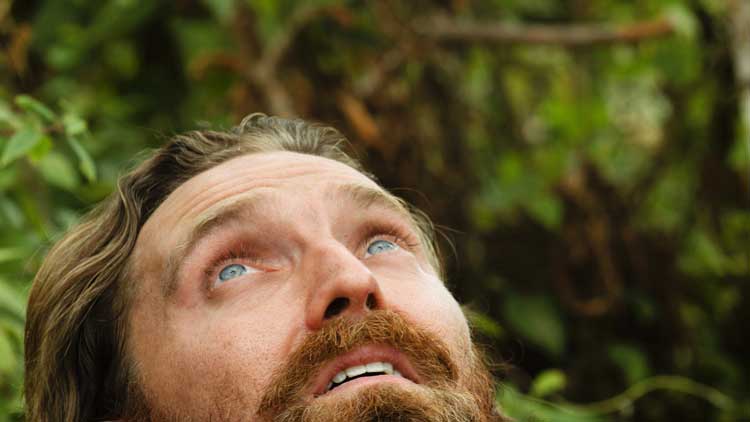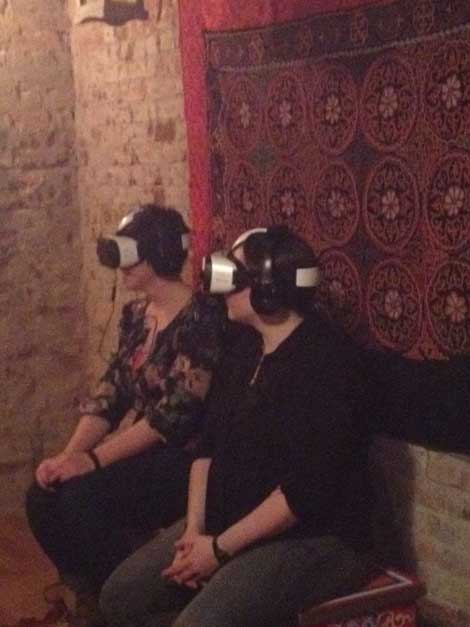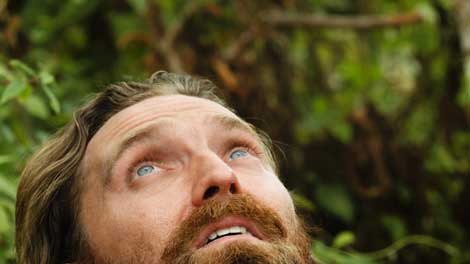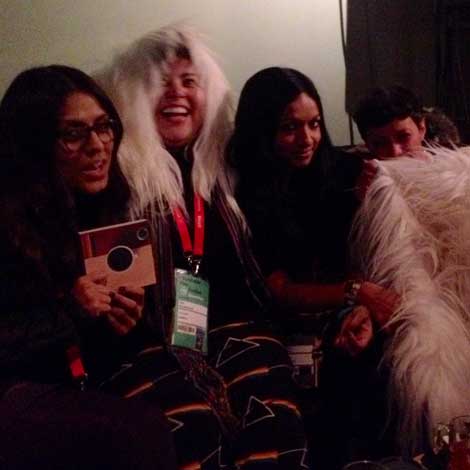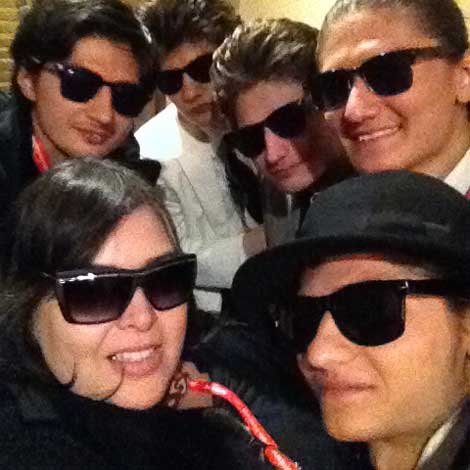I’m unclear what happened next but I do know after not getting into some parties (BET) and getting into others we ended up at the Celebration of Music in Film, highlighting the festival’s opening night film What Happened, Miss Simone? Performing at the event was Common, Erykah Badu, Aloe Blacc, Kate Davis, Andra Day and Al Schackman, Simone’s long time guitarist/musical director. The only way to describe the event was transporting. As a longtime Nina Simone devotee, hearing her songs deftly interpreted live was awesome: a wholly emotional experience, my hands in the air, tear-stained cheeks. “…Every body knows about Mississippi goddamn!” The flower of love was blooming at Sundance. I got several hugs from strangers, and not the creepy kind. Afterwards, there was nothing to do but bring our ecstatic energy to New Frontier, my home at Sundance. New Frontier is the expanded cinema limb of Sundance, exploding this year with its Ocular Evolution. We had been here before for the opening party, but then it was crowded and there was no way to experience the immersive quality, unless you were dogged, which I am not. But tonight was something different. Was it the Doug Aitkens’ party that I was trying to get invited to? I don’t know, but he was there and his film was playing and then there was this hair metal duo from Chicago, “White Mystery.” And a world class auctioneer, riffing on top of a droning score and Aitkens hugged me, in a pure way. How many parties have you moshed at and also napped at? That’s a good party.
The next day or maybe it was the day before led us to the Egyptian Theatre, my favorite movie house in town. One could imagine Tallulah Bankhead in a Q & A there. This particular afternoon was the screening of the digitally remastered Paris is Burning, the intimate portrait of New York’s Latino and black transsexual/transgender community, circa 1989. I was excited for the generous and energetic director, Jennie Livingston. This film was not only remastered, but also returned to its original aspect ratio! I know! John Cooper, the festival director, introduced the film and choked up a bit when he told the story of his first assignment at Sundance. It was 1991 and he had to watch some films at the Angelika Film Center. Paris is Burning was the first film he saw and thought, “Wow, if my job is going to be like this, it’s going to be amazing!” The film went on to share the Jury Grand Prize at Sundance in ’91 and here he was introducing that same film to be archived at UCLA—thanks to the collaboration between the Sundance Institute, the UCLA Film & Television Archive, and the Outfest Legacy Project. Let the good feelings flow. As Pepper says, “We are just a big group of human beings in a mutual bond.”
This was a film day and we rushed to catch a New Frontier film, Things of the Aimless Wanderer by Kivu Ruhorahoza. This is Kivu’s second feature and his first step into the “Anglo-Saxon” market. This complex film, set in Rwanda, about a romanticizing western (blue-eyed devil) news correspondent and a dispossessed African man is impressionistic with sparse and targeted dialog. A third character, a woman is involved as she gets disappeared several times in the imagination or at the hands of the two men. She is dragged and carried to isolated locations where she will or will not be found—she offs herself a couple of times too. The film employs the Rashomon effect. Maybe the most telling scene was of the two men ostensibly comparing penis sizes in the toilet, or so it was implied. It was a careful but disturbing film, so I asked Kivu to take a moment with me. I felt on the outside of grasping this particularly East African dynamic and he broke it down for me in black and white. The white man romanticizes the black woman with his ridiculous voice over in a British accent, complete with piano music tinkling in the background. (I should mention that when he, the new correspondent speaks, he has an American accent.) The black man infantilizes the woman, unsure how to respond to her newly found sexual freedom and his own perception of a slipping patriarchy. He himself feels irrelevant and society as a whole is going through another fresh round of rejecting western ways. The genocide left many women without brothers, partners and fathers. And for the director, the woman’s character is the most complex. I found her to be voiceless. To drive home the point in one scene she is wrapping tape over her own mouth. This woman has agency at different points in the stories as her role shifts, but the outcome is always the same for her, disappearance. I respect Kivu’s telling of a story I am only beginning to understand. He apologized for his English, saying that he usually conducts interviews in French and then he said, “The stories of women are still being told by men.” He is right.
Next we hopped the shuttle to see Entertainment, directed by Rick Alverson and written by the team of Alverson, Gregg Turkington (Neil Hamburger) and Tim Heidecker. This story of a caustic comedian played by Turkington—with a mean comb-over—was a menacing road trip film. The comedian is a loner and the treatment of the women in the film was to keep them at arms length. Even when he has a quite intimate experience with one female stranger we never see them touch. Turkington’s characterization of the comedian was draped over the script. He has this little upturned smile that appears at stressful moments just before sliding into a stoic despair. They really got the forlorn touring elements right. The backstage is always my favorite place, and a lot of stuff happens in the toilets—it was a bit of a bathroom film, especially in the way that bathrooms can be cold and bleak. The cinematic tropes were like familiar sign posts, instructing me to accept the descent. The soundscape was both charming and eerie. It felt like I was on a slow moving emotional roller coaster with blind corners, heading into the mines—if mines had roller coasters. I relished in the base humor of the comedian. He had me at an early joke, “Why don’t rapists eat at T.G.I. Friday’s?” You know those films where you catch yourself with a stupid smile plastered on your face? There were a few good Mexican culture cameos, but I’m not going to tell you what the film is about. See it if you have a dark sense of humor. I spotted Gregg in the bar before the screening and remarked on his style. “A letterman jacket on a middle aged man isn’t a good look,” I confessed this to him post-screening. He said he dressed that way to keep people from talking to him.
There was one film that people kept mentioning to me and since I couldn’t get a ticket to Tig, I headed to The Wolfpack. This film tells the story of the Angulo brothers, playfully named the Wolfpack by one of the filmmaker’s friends. The wolfpack were raised in isolation with each other in a lower east side apartment in Manhattan. Imagine a young hippy girl from Wisconsin meets a charismatic Peruvian guide on the Incan trail. They fall in love and decide to go to New York and make money to journey to an intentional community somewhere in the exotic land of Scandinavia. But instead they have kids and home-school them and try to shield them from the dangers that lurk at their doorstep. The brothers develop their own world and their own way of making sense of life and family through the blockbuster movies they watch and reenact. I could tell you every detail of this movie and it still wouldn’t prepare you for the originality and creativity exhibited by the astounding brothers—the gentleness imparted to them by their mother or the fiercely independent men they are becoming. It took a sensitive filmmaker like Crystal Mosselle to bring us this story. It’s an instant classic along the lines of Grey Gardens but with a hopeful ending. I saw Jennie Livingston at the screening. She mused on the future of this film and how it would eventually be in the UCLA archive. I sure hope so. This just in: The Wolfpack won the Grand Jury Prize for a documentary.
Nao Bustamante is an artist and educator. She is spending her sabbatical in LA where she will have a solo exhibit at VPAM on May 16th.
For more information: www.naobustamante.com

